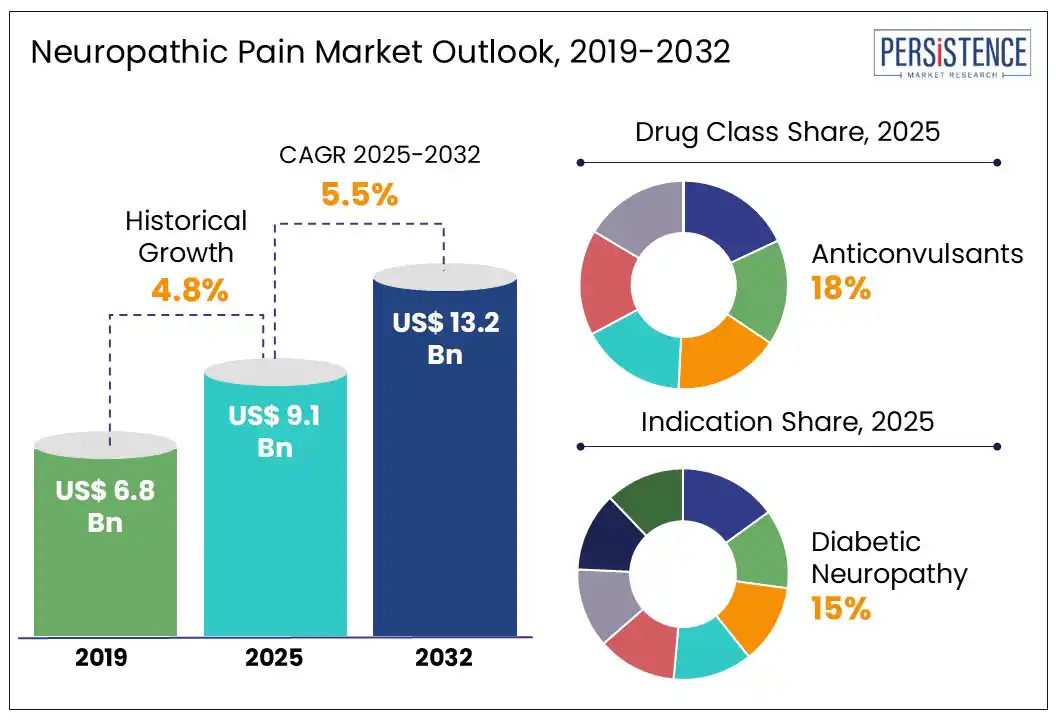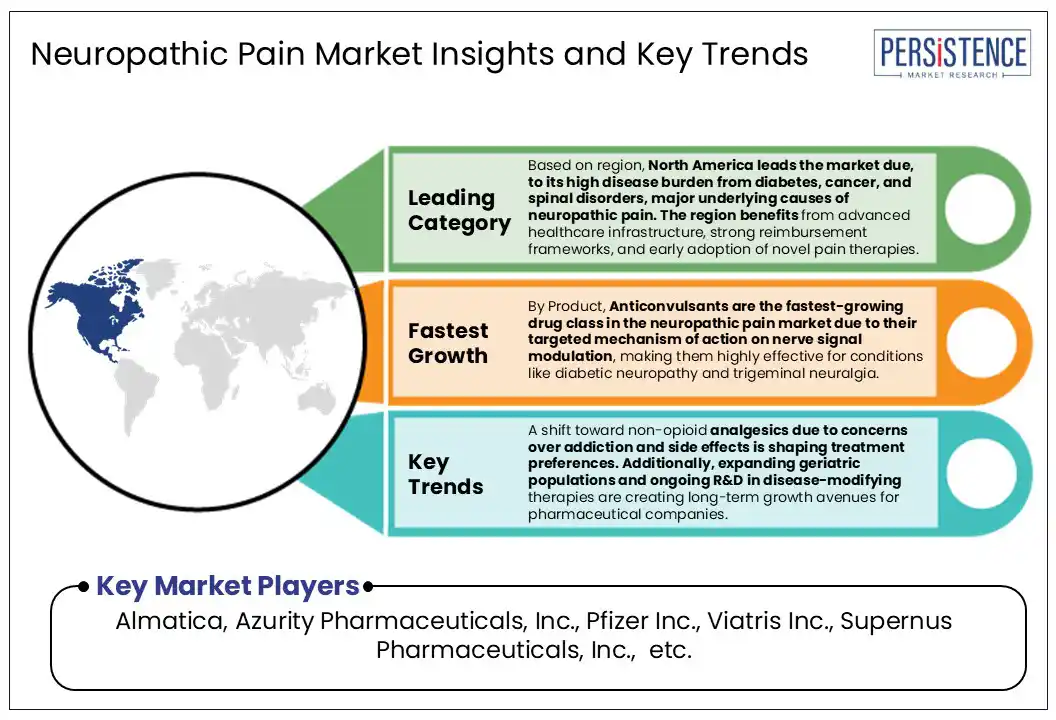ID: PMRREP4149| 191 Pages | 10 Jul 2025 | Format: PDF, Excel, PPT* | Healthcare

The global neuropathic pain market size is likely to be valued at US$9.1 Bn in 2025 and is estimated to reach US$13.2 Bn by 2032, growing at a CAGR of 5.5% during the forecast period from 2025-2032.
The neuropathic pain market is witnessing steady growth driven by the rising incidence of diabetes, cancer, spinal cord injuries, and postherpetic neuralgia, key contributors to nerve damage. Better diagnostic capabilities and advancements in pain management therapies, such as anticonvulsants, antidepressants, and topical treatments, add as a part to enhanced treatment features. The shift toward non-opioid alternatives due to regulatory pressures and opioid addiction concerns also shaping the therapeutic developments.

Key Industry Highlights:
The global rise in diabetes, driven by sedentary lifestyles, poor dietary habits, and aging populations, is significantly contributing to the increased burden of diabetic neuropathy one of the most prevalent forms of neuropathic pain. Studies suggest that nearly 50% of individuals with long-standing diabetes develop some form of nerve damage, leading to chronic pain, numbness, or tingling, primarily in the lower limbs. As diabetes becomes more widespread in low- and middle-income countries, the demand for effective neuropathic pain management solutions is escalating. Additionally, the earlier onset of Type 2 diabetes among younger populations increases the lifetime risk of developing painful diabetic neuropathy. This rising patient pool is pushing healthcare systems to prioritize innovative, cost-effective, and accessible treatment modalities.
Anticonvulsants and tricyclic antidepressants are commonly used as first-line therapies for neuropathic pain and may offer temporary relief. However, their use is often limited by adverse effects such as headaches, nausea, weight gain, skin reactions, or gastrointestinal disturbances. Although these side effects are generally mild and short-lived, some patients experience significant drowsiness, which can disrupt daily functioning.
Additionally, the high cost of branded neuropathic pain medications poses a major barrier, especially in developing regions. Due to affordability issues, patients in these markets tend to rely on generic alternatives, which in turn hampers the adoption and market penetration of premium branded drugs.
The current landscape of neuropathic pain management is dominated by symptomatic relief, with treatments primarily aimed at reducing pain intensity rather than addressing the root cause. This creates a significant unmet need for disease-modifying therapies (DMTs) that actively intervene in the pathophysiological mechanisms of nerve injury. Particularly in conditions such as diabetic neuropathy and post-herpetic neuralgia, where progressive nerve degeneration is common, the development of agents that promote nerve regeneration, reduce neuroinflammation, or halt axonal damage offers transformative potential. Advances in molecular biology, neuroimmunology, and gene therapy are paving the way for novel interventions targeting disease pathways. DMTs focus on long-term outcomes and reduce dependency on chronic drug use, positioning them as a breakthrough opportunity in neuropathic care.
Anticonvulsants account for the highest share in the neuropathic pain market due to their proven efficacy, broad usage, and strong clinical endorsement. Medications such as gabapentin and pregabalin are widely prescribed as first-line treatments, particularly for conditions such as diabetic peripheral neuropathy, post-herpetic neuralgia, and central pain syndromes. These drugs work by modulating calcium channels and reducing excitatory neurotransmission, effectively dampening abnormal nerve signals. Their ability to target the underlying neuronal hyperexcitability makes them more effective than many traditional analgesics. Additionally, they have a relatively favorable safety profile and a lower risk of addiction compared to opioids, leading to higher patient and physician preference. Extensive global use, regulatory approvals, and wide insurance coverage further reinforce their dominant market position.
Diabetic neuropathy is poised to account for a large share due to the sheer global burden of diabetes and its high complication rate. Nearly half of all diabetic patients develop some form of nerve damage, primarily in the lower extremities, resulting in chronic pain, numbness, and mobility issues. This persistent and progressive condition requires long-term management, fueling consistent demand for pharmacological and non-pharmacological treatments. Additionally, diabetic neuropathy is often underdiagnosed in screening and diagnosis initiatives worldwide.
Retail pharmacies dominate the distribution of neuropathic pain treatments due to their accessibility, convenience, and central role in chronic disease management. As neuropathic pain is primarily treated on an outpatient basis, patients frequently visit retail outlets to refill prescriptions for long-term therapies such as antidepressants, anticonvulsants, and topical agents. These pharmacies offer easier access, extended operating hours, and personalized services that enhance patient compliance. Additionally, widespread insurance integration and pharmacist counseling further support their prominence.

The North America neuropathic pain market is witnessing robust growth, driven by the high prevalence of diabetes, shingles, and chemotherapy-induced neuropathy, especially in the U.S. Advanced healthcare infrastructure, early diagnosis, and access to innovative pain management therapies support market expansion. The U.S. leads due to the strong R&D investments, favorable reimbursement policies, and rising adoption of non-opioid and adjuvant therapies. Moreover, FDA approvals for novel drug formulations and increasing focus on personalized pain management are reshaping the therapeutic landscape, making North America a key innovation hub in this domain.
Europe neuropathic pain market is expanding steadily, driven by an aging population and rising incidence of conditions like multiple sclerosis, stroke, and spinal cord injuries. For instance, according to data published by The British Diabetic Association in May 2024, approximately 4.3 million people in the U.K. are living with diabetes which is a high risk factor for neuropathic complications.
Countries such as Germany, France, and the U.K. are emphasizing non-opioid pain relief and multidisciplinary care approaches. EU-wide regulatory harmonization has accelerated the approval of novel therapies and generics, improving patient access. Public healthcare systems and increased awareness of chronic pain further support early intervention and improved patient outcomes.
Asia Pacific neuropathic pain market is emerging rapidly, fueled by a rise in diabetes prevalence, expanding healthcare access, and increasing neurological disorder diagnoses. Countries such as India, China, and Indonesia are experiencing a shift toward modern pain management due to urbanization and changing lifestyles. Government-led healthcare reforms and growing investments in rural health infrastructure are improving diagnosis and treatment rates. Additionally, pharmaceutical companies are targeting the region for clinical trials and affordable generic drugs, positioning Asia Pacific as a high-potential growth frontier for neuropathic pain therapies.
The competitive landscape of the global neuropathic pain market is shaped by continuous innovation, pipeline diversification, and the shift toward safer, non-opioid therapies. Market players are intensifying research on novel mechanisms targeting nerve damage and inflammation. Partnerships between pharmaceutical firms and academic institutions are accelerating clinical development, especially for rare neuropathic conditions.
The global neuropathic pain market is estimated to increase from US$9.1 Bn in 2025 to US$13.2 Bn in 2032.
The global neuropathic pain market is propelled by the rising prevalence of diabetes, cancer, and neurological disorders, along with increased awareness, improved diagnostics, and the demand for non-opioid, targeted pain management therapies.
The neuropathic pain market is projected to record a CAGR of 5.5% during the forecast period from 2025 to 2032.
The development of disease-modifying therapies, expansion in emerging economies, personalized pain management approaches, and increased adoption of non-opioid and combination treatments.
North America dominates the global neuropathic pain market.
|
Report Attribute |
Details |
|
Neuropathic Pain Market Size (2025E) |
US$ 9.1 Bn |
|
Market Value Forecast (2032F) |
US$ 13.2 Bn |
|
Projected Growth (CAGR 2025 to 2032) |
5.5% |
|
Historical Market Growth (CAGR 2019 to 2024) |
4.8% |
|
Historical Data/Actuals |
2019 - 2024 |
|
Forecast Period |
2025 - 2032 |
|
Market Analysis |
US$ Bn for Value |
|
Geographical Coverage |
|
|
Segmental Coverage |
|
|
Competitive Analysis |
|
|
Report Highlights |
|
|
Customization and Pricing |
Available upon request |
By Drug Class
By Indication
By Route of Administration
By Distribution Channel
By Region
Delivery Timelines
For more information on this report and its delivery timelines please get in touch with our sales team.
About Author